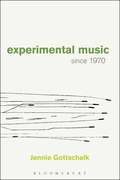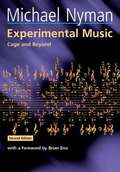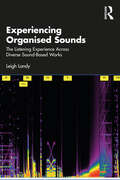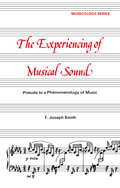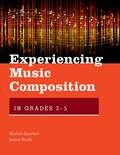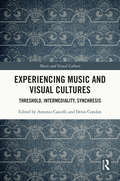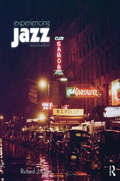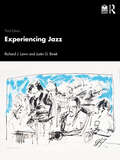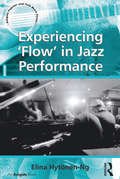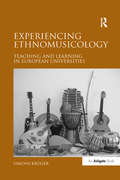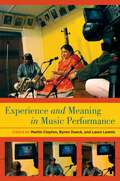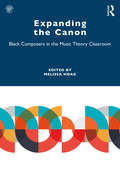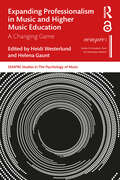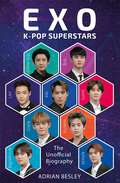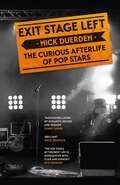- Table View
- List View
Experimental Music Since 1970
by Jennie GottschalkWhat is experimental music today? This book offers an up to date survey of this field for anyone with an interest, from seasoned practitioners to curious readers. This book takes the stance that experimental music is not a limited historical event, but is a proliferation of approaches to sound that reveals much about present-day experience. An experimental work is not identifiable by its sound alone, but by the nature of the questions it poses and its openness to the sounding event.Experimentation is a way of working. It pushes past that which is known to discover what lies beyond it, finding new knowledge, forms, and relationships, or accepting a state of uncertainty. For each of these composers and sound artists, craft is developed and transformed in response to the questions they bring to their work. Scientific, perceptual, or social phenomena become catalysts in the operation of the work. These practices are not presented according to a chronology, a set of techniques, or social groupings. Instead, they are organized according to the content areas that are their subjects, including resonance, harmony, objects, shapes, perception, language, interaction, sites, and histories. Musical materials may be subject, among other treatments, to systemization, observation, examination, magnification, fragmentation, translation, or destabilization. These restless and exploratory modes of engagement have continued to develop over recent decades, expanding the scope of both musical practice and listening.
Experimental Music: Cage and Beyond (PDF)
by Michael Nyman Foreword by Brian EnoMichael Nyman's book is a first-hand account of experimental music from 1950 to 1970. First published in 1974, it has remained the classic text on a significant form of music making and composing which developed alongside, and partly in opposition to, the post-war modernist tradition of composers such as Boulez, Berio, or Stockhausen. The experimentalist par excellence was John Cage whose legendary 4' 33'' consists of four minutes and thirty three seconds of silence to be performed on any instrument. Such pieces have a conceptual rather than purely musical starting point and radically challenge conventional notions of the musical work. Nyman's book traces the revolutionary attitudes that were developed towards concepts of time, space, sound, and composer/performer responsibility. It was within the experimental tradition that the seeds of musical minimalism were sown and the book contains reference to the early works of Reich, Riley, Young, and Glass.
Experiencing Organised Sounds: The Listening Experience Across Diverse Sound-Based Works
by Leigh LandyExperiencing Organised Sounds investigates a wide horizon of sound-based works using a template consistently across its 16 studies. It has been written for both specialist and non-specialist readers aiming to address means of increasing appreciation and understanding related to the experience of sonic creativity (music involving any sounds, not just musical notes) across this repertoire, as well as to launch a discussion about how the reception of sonic creativity can be influenced by the circumstances of listening – in particular, regarding the qualitative difference between the in-situ as opposed to mediated experience. Although listening is the volume’s focus, complementary information from the musicians is offered to facilitate holistic work overviews. As the first composition presented was composed by a 15-year-old, the intention is to demonstrate that what might be considered a niche area of the contemporary arts is one in which both increased appreciation and participation could and should easily be achieved. The book’s work discussions are divided over three central chapters focused on fixed-medium compositions, performed and sound artworks. Experiencing Organised Sounds can be used as an undergraduate textbook, by experienced readers or those new to the area. All works discussed and related materials are available to readers online.
Experiencing Organised Sounds: The Listening Experience Across Diverse Sound-Based Works
by Leigh LandyExperiencing Organised Sounds investigates a wide horizon of sound-based works using a template consistently across its 16 studies. It has been written for both specialist and non-specialist readers aiming to address means of increasing appreciation and understanding related to the experience of sonic creativity (music involving any sounds, not just musical notes) across this repertoire, as well as to launch a discussion about how the reception of sonic creativity can be influenced by the circumstances of listening – in particular, regarding the qualitative difference between the in-situ as opposed to mediated experience. Although listening is the volume’s focus, complementary information from the musicians is offered to facilitate holistic work overviews. As the first composition presented was composed by a 15-year-old, the intention is to demonstrate that what might be considered a niche area of the contemporary arts is one in which both increased appreciation and participation could and should easily be achieved. The book’s work discussions are divided over three central chapters focused on fixed-medium compositions, performed and sound artworks. Experiencing Organised Sounds can be used as an undergraduate textbook, by experienced readers or those new to the area. All works discussed and related materials are available to readers online.
Experiencing of Musical Sound: A Prelude to a Phenomenology of Music (Musicology)
by F. J. SmithFirst Published in 1979. Routledge is an imprint of Taylor & Francis, an informa company.
Experiencing of Musical Sound: A Prelude to a Phenomenology of Music (Musicology)
by F. J. SmithFirst Published in 1979. Routledge is an imprint of Taylor & Francis, an informa company.
EXPERIENCING MUSIC GRADES 3-5 EMC C (Experiencing Music Composition)
by Janice Smith Michele KaschubExperiencing Music Composition in Grades 3-5 is a practical guide to new, innovative, and natural composition techniques for young composers. Music Educators Michele Kaschub and Janice Smith bring a wealth of experience to bear a unique and thoughtfully curated series of materials that help teachers connect music education to young composers' everyday emotions and activities . Divided into four sections, Kaschub and Smith's book illustrates a creative roadmap for instilling a sense of creative independence in students ages 8-11. The first section introduces readers to three distinct compositional ideals that are as educationally significant as the music they help create: feelingful intention, musical expressivity, and artistic craftsmanship. These capacities help springboard children's work from sounds and brief musical gestures to thoughtfully created, expressive musical pieces. Section 2 includes fun and imaginative lessons that are accompanied by Sketchpages-graphic worksheets that support deep consideration of a project's purpose during the compositional process. Lessons also include invaluable suggestions for productive sharing in a variety of formats. Section 3 offers guidance and strategies for sharing work, providing feedback, and encouraging future growth in a manner that fosters a positive learning experience and acknowledges each composer's musical autonomy. Section 4 contains additional teacher guides focused on creating original music in different genres. These guides outline multiple approaches to corresponding lessons and jumpstart activity while serving as developmental models. Experiencing Music Composition: Grades 3-5 offers new ways to promote not only creative intuition in children but also independent thought, preparing students for a fulfilling relationship with music.
Experiencing Music Composition in Grades 3-5 (Experiencing Music Composition)
by Michele Kaschub Janice SmithExperiencing Music Composition in Grades 3-5 is a practical guide to new, innovative, and natural composition techniques for young composers. Music Educators Michele Kaschub and Janice Smith bring a wealth of experience to bear a unique and thoughtfully curated series of materials that help teachers connect music education to young composers' everyday emotions and activities . Divided into four sections, Kaschub and Smith's book illustrates a creative roadmap for instilling a sense of creative independence in students ages 8-11. The first section introduces readers to three distinct compositional ideals that are as educationally significant as the music they help create: feelingful intention, musical expressivity, and artistic craftsmanship. These capacities help springboard children's work from sounds and brief musical gestures to thoughtfully created, expressive musical pieces. Section 2 includes fun and imaginative lessons that are accompanied by Sketchpages-graphic worksheets that support deep consideration of a project's purpose during the compositional process. Lessons also include invaluable suggestions for productive sharing in a variety of formats. Section 3 offers guidance and strategies for sharing work, providing feedback, and encouraging future growth in a manner that fosters a positive learning experience and acknowledges each composer's musical autonomy. Section 4 contains additional teacher guides focused on creating original music in different genres. These guides outline multiple approaches to corresponding lessons and jumpstart activity while serving as developmental models. Experiencing Music Composition: Grades 3-5 offers new ways to promote not only creative intuition in children but also independent thought, preparing students for a fulfilling relationship with music.
Experiencing Music and Visual Cultures: Threshold, Intermediality, Synchresis (Music and Visual Culture)
by Antonio Cascelli Denis CondonBringing the research of musicologists, art historians, and film studies scholars into dialogue, this book explores the relationships between visual art forms and music. The chapters are organized around three core concepts – threshold, intermediality, and synchresis – which offer ways of understanding and discusssing the interplay between the arts of sounds and images. Refuting the idea that music and visual art forms only operate in parallel, the contributors instead consider how the arts of sound and vision are entwined across a wide array of materials, genres and time periods. Contributors delve into a rich variety of topics, ranging from the art of Renaissance Italy to the politics of opera in contemporary Los Angeles to the popular television series Breaking Bad. Placing these chapters in conversation, this volume develops a shared language for cross-disciplinary inquiry into arts that blend music and visual components, integrates insights from film studies with the conversation between musicology and art history, and moves the study of music and visual culture forward.
Experiencing Music and Visual Cultures: Threshold, Intermediality, Synchresis (Music and Visual Culture)
by Antonio Cascelli Denis CondonBringing the research of musicologists, art historians, and film studies scholars into dialogue, this book explores the relationships between visual art forms and music. The chapters are organized around three core concepts – threshold, intermediality, and synchresis – which offer ways of understanding and discusssing the interplay between the arts of sounds and images. Refuting the idea that music and visual art forms only operate in parallel, the contributors instead consider how the arts of sound and vision are entwined across a wide array of materials, genres and time periods. Contributors delve into a rich variety of topics, ranging from the art of Renaissance Italy to the politics of opera in contemporary Los Angeles to the popular television series Breaking Bad. Placing these chapters in conversation, this volume develops a shared language for cross-disciplinary inquiry into arts that blend music and visual components, integrates insights from film studies with the conversation between musicology and art history, and moves the study of music and visual culture forward.
Experiencing Jazz: eBook Only
by Richard J. LawnExperiencing Jazz, Second Edition, is an integrated textbook with online resources for jazz appreciation and history courses. Through readings, illustrations, timelines, listening guides, and a streaming audio library, it immerses the reader in a journey through the history of jazz, while placing the music within a larger cultural and historical context. Designed to introduce the novice to jazz, Experiencing Jazz describes the elements of music, and the characteristics and roles of different instruments. Prominent artists and styles from the roots of jazz to present day are relayed in a story-telling prose. This new edition features expanded coverage of women in jazz, the rise of jazz as a world music, the influence of Afro-Cuban and Latin jazz, and streaming audio. Features: Important musical trends are placed within a broad cultural, social, political, and economic context Music fundamentals are treated as integral to the understanding of jazz, and concepts are explained easily with graphic representations and audio examples Comprehensive treatment chronicles the roots of jazz in African music to present day Commonly overlooked styles, such as orchestral jazz, Cubop, and third-stream jazz are included Expanded and up-to-date coverage of women in jazz The media-rich companion website presents a comprehensive streaming audio library of key jazz recordings by leading artists integrated with interactive listening guides. Illustrated musical concepts with web-based tutorials and audio interviews of prominent musicians acquaint new listeners to the sounds, styles, and figures of jazz. Course components The complete course comprises the textbook and Online Access to Music token, which are available to purchase separately. The textbook and Online Access to Music Token can also be purchased together in the Experiencing Jazz Book and Online Access to Music Pack. Book and Online Access to Music Pack: 978-0-415-65935-2 (Paperback and Online Access to Music) Book Only: 978-0-415-69960-0 (please note this does not include the Online Access to Music) Online Access to Music Token: 978-0-415-83735-4 (please note this does not include the textbook) eBook and Online Access to Music Pack: 978-0-203-37981-3 (available from the Taylor & Francis eBookstore) ebook: 978-0-203-37985-1 (please note this does not include the audio and is available from the Taylor & Francis eBookstore)
Experiencing Jazz: eBook Only
by Richard J. LawnExperiencing Jazz, Second Edition, is an integrated textbook with online resources for jazz appreciation and history courses. Through readings, illustrations, timelines, listening guides, and a streaming audio library, it immerses the reader in a journey through the history of jazz, while placing the music within a larger cultural and historical context. Designed to introduce the novice to jazz, Experiencing Jazz describes the elements of music, and the characteristics and roles of different instruments. Prominent artists and styles from the roots of jazz to present day are relayed in a story-telling prose. This new edition features expanded coverage of women in jazz, the rise of jazz as a world music, the influence of Afro-Cuban and Latin jazz, and streaming audio. Features: Important musical trends are placed within a broad cultural, social, political, and economic context Music fundamentals are treated as integral to the understanding of jazz, and concepts are explained easily with graphic representations and audio examples Comprehensive treatment chronicles the roots of jazz in African music to present day Commonly overlooked styles, such as orchestral jazz, Cubop, and third-stream jazz are included Expanded and up-to-date coverage of women in jazz The media-rich companion website presents a comprehensive streaming audio library of key jazz recordings by leading artists integrated with interactive listening guides. Illustrated musical concepts with web-based tutorials and audio interviews of prominent musicians acquaint new listeners to the sounds, styles, and figures of jazz. Course components The complete course comprises the textbook and Online Access to Music token, which are available to purchase separately. The textbook and Online Access to Music Token can also be purchased together in the Experiencing Jazz Book and Online Access to Music Pack. Book and Online Access to Music Pack: 978-0-415-65935-2 (Paperback and Online Access to Music) Book Only: 978-0-415-69960-0 (please note this does not include the Online Access to Music) Online Access to Music Token: 978-0-415-83735-4 (please note this does not include the textbook) eBook and Online Access to Music Pack: 978-0-203-37981-3 (available from the Taylor & Francis eBookstore) ebook: 978-0-203-37985-1 (please note this does not include the audio and is available from the Taylor & Francis eBookstore)
Experiencing Jazz
by Richard J. Lawn Justin G. BinekExperiencing Jazz, Third Edition is an integrated textbook, website, and audio anthology for jazz appreciation and history courses. Through readings, illustrations, timelines, listening guides, and a playlist of tracks and performances, Experiencing Jazz journeys through the history of jazz and places the music within larger cultural and historical contexts. Designed for the jazz novice, this textbook introduces the reader to prominent artists, covers the evolution of styles, and makes stylistic comparisons to current trends and developments. New to the third edition: Richard J. Lawn is joined by new co-author Justin G. Binek Expanded coverage of artists, particularly important vocalists and prominent women in jazz, including Bobby McFerrin, Kurt Elling, The Manhattan Transfer, and Terri Lyne Carrington A dynamic, web-exclusive bonus chapter—Chapter 14.5: The Story Continues—exploring contemporary jazz artists who push the boundaries of jazz by creating new stylistic fusions and who utilize new media to create, collaborate, and share their artistry A re-worked companion website featuring new recordings, a more comprehensive audio anthology, and a major revision of The Elements of Jazz section Condensed musician biographies and updated content reflecting jazz’s global impact Revised listening guides for spotlighted recordings highlighting key moments worthy of closer listening and analysis Comprehensive and immersive, the third edition of Experiencing Jazz provides a foundational understanding of the history of the genre.
Experiencing Jazz
by Richard J. Lawn Justin G. BinekExperiencing Jazz, Third Edition is an integrated textbook, website, and audio anthology for jazz appreciation and history courses. Through readings, illustrations, timelines, listening guides, and a playlist of tracks and performances, Experiencing Jazz journeys through the history of jazz and places the music within larger cultural and historical contexts. Designed for the jazz novice, this textbook introduces the reader to prominent artists, covers the evolution of styles, and makes stylistic comparisons to current trends and developments. New to the third edition: Richard J. Lawn is joined by new co-author Justin G. Binek Expanded coverage of artists, particularly important vocalists and prominent women in jazz, including Bobby McFerrin, Kurt Elling, The Manhattan Transfer, and Terri Lyne Carrington A dynamic, web-exclusive bonus chapter—Chapter 14.5: The Story Continues—exploring contemporary jazz artists who push the boundaries of jazz by creating new stylistic fusions and who utilize new media to create, collaborate, and share their artistry A re-worked companion website featuring new recordings, a more comprehensive audio anthology, and a major revision of The Elements of Jazz section Condensed musician biographies and updated content reflecting jazz’s global impact Revised listening guides for spotlighted recordings highlighting key moments worthy of closer listening and analysis Comprehensive and immersive, the third edition of Experiencing Jazz provides a foundational understanding of the history of the genre.
Experiencing 'Flow' in Jazz Performance (Ashgate Popular and Folk Music Series)
by Elina Hytonen-NgThe term 'flow' refers to experiences where the musician moves into a consciousness in which time seems to be suspended and perception of reality is blurred by unconscious forces. An essential part of the jazz tradition, which often serves as the foundation of the musician's identity, flow is recognised within the greater jazz community as a critical factor in accomplished musicianship. Flow as a concept is so deeply embedded in the scene that these experiences are not generally discussed. It contributes to the musicians' work motivation, providing a vital level of satisfaction and accomplishment. The power of the experience, consciously or unconsciously, has given rise to the creation of heroic images, in which jazz musicians are seen as being bold, yet vulnerable, strong and masculine, but still capable of expressing emotions. In this discourse, musicians are pictured as people constantly putting themselves on the line, exposing themselves and their hearts to one another as well as to the audience. Heroic profiles are richly constructed within the jazz scene, and their incorporation into narratives of flow suggests that such images are inseparable from jazz. It is thus unclear how far the musicians are simply reporting personal experience as opposed to unconsciously perpetuating a profoundly internalised mythology. Drawing on eighteen interviews conducted with professional jazz musicians from around the world, Elina Hytönen-Ng examines the fundamentals of the phenomenon of flow in jazz that has led to this genre's popularity. Furthermore, she draws on how flow experiences are viewed and constructed by jazz musicians, the meanings they attach to it, and the quality of music that it inspires.
Experiencing 'Flow' in Jazz Performance (Ashgate Popular and Folk Music Series)
by Elina Hytonen-NgThe term 'flow' refers to experiences where the musician moves into a consciousness in which time seems to be suspended and perception of reality is blurred by unconscious forces. An essential part of the jazz tradition, which often serves as the foundation of the musician's identity, flow is recognised within the greater jazz community as a critical factor in accomplished musicianship. Flow as a concept is so deeply embedded in the scene that these experiences are not generally discussed. It contributes to the musicians' work motivation, providing a vital level of satisfaction and accomplishment. The power of the experience, consciously or unconsciously, has given rise to the creation of heroic images, in which jazz musicians are seen as being bold, yet vulnerable, strong and masculine, but still capable of expressing emotions. In this discourse, musicians are pictured as people constantly putting themselves on the line, exposing themselves and their hearts to one another as well as to the audience. Heroic profiles are richly constructed within the jazz scene, and their incorporation into narratives of flow suggests that such images are inseparable from jazz. It is thus unclear how far the musicians are simply reporting personal experience as opposed to unconsciously perpetuating a profoundly internalised mythology. Drawing on eighteen interviews conducted with professional jazz musicians from around the world, Elina Hytönen-Ng examines the fundamentals of the phenomenon of flow in jazz that has led to this genre's popularity. Furthermore, she draws on how flow experiences are viewed and constructed by jazz musicians, the meanings they attach to it, and the quality of music that it inspires.
Experiencing Ethnomusicology: Teaching and Learning in European Universities
by Simone Kr�gerSimone Kr�ger provides an innovative account of the transmission of ethnomusicology in European universities, and explores the ways in which students experience and make sense of their musical and extra-musical encounters. By asking questions as to what students learn about and through world musics (musically, personally, culturally), Kr�ger argues that musical transmission, as a reflector of social and cultural meaning, can impact on students' transformations in attitude and perspectives towards self and other. In doing so, the book advances current discourse on the politics of musical representation in university education as well as on ethnomusicology learning and teaching, and proposes a model for ethnomusicology pedagogy that promotes in students a globally, contemporary and democratically informed sense of all musics.
Experiencing Ethnomusicology: Teaching and Learning in European Universities
by Simone Kr�gerSimone Kr�ger provides an innovative account of the transmission of ethnomusicology in European universities, and explores the ways in which students experience and make sense of their musical and extra-musical encounters. By asking questions as to what students learn about and through world musics (musically, personally, culturally), Kr�ger argues that musical transmission, as a reflector of social and cultural meaning, can impact on students' transformations in attitude and perspectives towards self and other. In doing so, the book advances current discourse on the politics of musical representation in university education as well as on ethnomusicology learning and teaching, and proposes a model for ethnomusicology pedagogy that promotes in students a globally, contemporary and democratically informed sense of all musics.
Experience and Meaning in Music Performance
by Martin Clayton Byron Dueck Laura LeanteHow does the immediate experience of musical sound relate to processes of meaning construction and discursive mediation? This question lies at the heart of the studies presented in Experience and Meaning in Music Performance, a unique multi-authored work that both draws on and contributes to current debates in a wide range of disciplines, including ethnomusicology, musicology, psychology, and cognitive science. Addressing a wide range of musical practices from Indian raga and Afro-Brazilian Congado rituals to jazz, rock, and Canadian aboriginal fiddling, the coherence of this study is underpinned by its three main themes: experience, meaning, and performance. Central to all of the studies are moments of performance: those junctures when sound and meaning are actually produced. Experience-what people do, and what they feel, while engaging in music-is equally important. And considered alongside these is meaning: what people put into a performance, what they (and others) get out of it, and, more broadly, how discourses shape performances and experiences of music. In tracing trajectories from moments of musical execution, this volume a novel and productive view of how cultural practice relates to the experience and meaning of musical performance. A model of interdisciplinary study, and including access to an array of audio-visual materials available on an extensive companion website, Experience and Meaning in Music Performance is essential reading for scholars and students of ethnomusicology and music psychology.
Expanding the Canon: Black Composers in the Music Theory Classroom
by Melissa HoagDirectly addressing the underrepresentation of Black composers in core music curricula, Expanding the Canon: Black Composers in the Music Theory Classroom aims to both demonstrate why diversification is badly needed and help faculty expand their teaching with practical, classroom-oriented lesson plans that focus on teaching music theory with music by Black composers. This collection of 21 chapters is loosely arranged to resemble a typical music theory curriculum, with topics progressing from basic to advanced and moving from fundamentals, diatonic harmony, and chromatic harmony to form, popular music, and music of the twentieth and twenty-first centuries. Some chapters focus on segments of the traditional music theory sequence, while others consider a single style or composer. Contributors address both methods to incorporate the music of Black composers into familiar topics, and ways to rethink and expand the purview of the music theory curriculum. A foreword by Philip Ewell and an introductory narrative by Teresa L. Reed describing her experiences as an African American student of music set the volume in wider context. Incorporating a wide range of examples by composers across classical, jazz, and popular genres, this book helps bring the rich and varied body of music by Black composers into the core of music theory pedagogy and offers a vital resource for all faculty teaching music theory and analysis.
Expanding the Canon: Black Composers in the Music Theory Classroom
by Melissa HoagDirectly addressing the underrepresentation of Black composers in core music curricula, Expanding the Canon: Black Composers in the Music Theory Classroom aims to both demonstrate why diversification is badly needed and help faculty expand their teaching with practical, classroom-oriented lesson plans that focus on teaching music theory with music by Black composers. This collection of 21 chapters is loosely arranged to resemble a typical music theory curriculum, with topics progressing from basic to advanced and moving from fundamentals, diatonic harmony, and chromatic harmony to form, popular music, and music of the twentieth and twenty-first centuries. Some chapters focus on segments of the traditional music theory sequence, while others consider a single style or composer. Contributors address both methods to incorporate the music of Black composers into familiar topics, and ways to rethink and expand the purview of the music theory curriculum. A foreword by Philip Ewell and an introductory narrative by Teresa L. Reed describing her experiences as an African American student of music set the volume in wider context. Incorporating a wide range of examples by composers across classical, jazz, and popular genres, this book helps bring the rich and varied body of music by Black composers into the core of music theory pedagogy and offers a vital resource for all faculty teaching music theory and analysis.
Expanding Professionalism in Music and Higher Music Education: A Changing Game (ISSN)
by Heidi Westerlund Helena GauntThis book addresses the need to rethink the concept and enactment of professionalism in music, and how such concepts underpin professional higher music education. There is an urgent imperative to enable the potential of professional musicians in our contemporary societies to be more fully realised, recognising both intense challenges that are currently threatening some traditional music practices, and significant scope for new practices to be imagined in response to deep veins of societal need. Professionalism encompasses the conduct, aims, values, responsibilities and ongoing development of a practising professional in the field. Professional higher music education engages both with providing future professionals with relevant education in particular craft skills, and with nurturing their visions for their work as artists in future societies. The major focus of the book is on performance traditions that have dominated professional higher education, notably western classical music.
Expanding Professionalism in Music and Higher Music Education: A Changing Game (ISSN)
by Heidi Westerlund Helena GauntThis book addresses the need to rethink the concept and enactment of professionalism in music, and how such concepts underpin professional higher music education. There is an urgent imperative to enable the potential of professional musicians in our contemporary societies to be more fully realised, recognising both intense challenges that are currently threatening some traditional music practices, and significant scope for new practices to be imagined in response to deep veins of societal need. Professionalism encompasses the conduct, aims, values, responsibilities and ongoing development of a practising professional in the field. Professional higher music education engages both with providing future professionals with relevant education in particular craft skills, and with nurturing their visions for their work as artists in future societies. The major focus of the book is on performance traditions that have dominated professional higher education, notably western classical music.
EXO: K-Pop Superstars
by Adrian BesleyA K-pop band like no other, EXO have been dominating charts and stealing hearts since they debuted in 2012. For the first time, this unofficial biography will tell their extraordinary story. Extensively researched, this book weaves in the backstories of each of the nine individual members with the story of the band as a whole, as well as detailing the support from their incredible fanbase, EXO-L. As any EXO-L knows, EXO come from an alien planet and possess superpowers – not hard to believe when you see how talented they are! They record their songs in Korean, Mandarin and Japanese, they have millions of fans all over the world, their music videos clock up hundreds of millions of views, and a captivated global audience watched this Korean-Chinese band close the 2018 Winter Olympics in South Korea. No wonder Dazed magazine called them the ‘biggest Korean boyband in the world’.Featuring biographies of each of the nine current members – Suho, Xiumin, Lay, Baekhyun, Chen, Chanyeol, D.O., Kai and Sehun – as well as previous members Luhan, Kris and Tao, and taking an in-depth look at what makes them stand out from the K-pop crowd, this accessible and upbeat book is a must for all fans of one of the biggest bands on the planet.
Exit Stage Left: The curious afterlife of pop stars
by Nick Duerden'Exit Stage Left is the book I've long wanted to read about the PTSD-like after-effects of pop stardom - and Nick Duerden is the perfect writer for the job. The pop star's bittersweet lot - the mass adoration that comes with pop stardom, followed by the bathetic comedown of what inevitably follows - is represented with flair and empathy.' - Pete Paphides, author of Broken Greek'Tragedy, genius, addiction and inspiration: Exit Stage Left is a comprehensive tour through all the ways life can go wrong post-fame (and the few ways it can go right). Funny, poignant and often inspirational.' - Mat Osman 'Duerden finds fascinating layers of humanity, pathos, humour and wisdom in equal measure. A brilliant book, for artists and fans alike.' - Frank Turner'Fame is the brightest candle, but in this brilliant collection of interviews, Nick Duerden answers the question: what does a candle do after it's burned out?' - David Quantick The desire for adulation is a light that never goes out. We live in a culture obsessed by the notion of fame - the heedless pursuit of it; the almost obligatory subsequent fallout. But what's it like to actually achieve it, and what happens when fame abruptly passes, and shifts, as it does, onto someone else?This is the world the pop star is required to inhabit. It's invariably eventful. We know all about them when they're at the top of their game, of course, but they tend to reveal far more of their true selves once they've peaked, and are on their way down. This is the point at which they are at their most heroic, because they don't give up. They keep on striving, keep making music, and refuse simply to ebb away. Some sustain themselves on the nostalgia circuit, others continue to beaver away in the studio, no longer Abbey Road, perhaps, so much as the garden shed. But all of them, in their own individual ways, still dare to dream.Exit Stage Left features tales of drug addiction, bankruptcy, depression and divorce, but also of optimism, a genuine love of the craft, humility and hope. This is a candid, laugh-out-loud and occasionally shocking look at what happens when the brightest stars fall back down to earth.Featuring brand new interviews with the likes of: Bob Geldof, Shaun Ryder, Robbie Williams, Roisin Murphy, Stewart Copeland, Billy Bragg, Wendy James, Alex Kapranos, Joan Armatrading, Leo Sayer, Gary Lightbody, Lisa Maffia, Tim Booth, Bill Drummond, Rufus Wainwright, David Gray, and Justin Hawkins.
